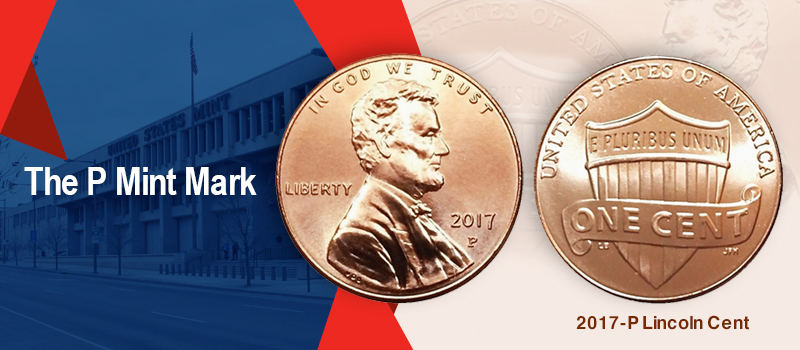The P Mint Mark

Mint Marks - The origin
Many would think mint marks were invented by us. What with so many mints spread across the country since the 18th century! But that's not the case. These marks that indicate at a glance (within a 1 inch coin, no less!)which mint a coin came out ofare as old as time itself!
The mint mark owes its origin to the Greeks, probably around the 1st century A.D. They were originally called 'Magistrate Marks' and showed the mark of the Magistrate who was in charge of producing the coin. When Alexander the Great conquered other lands, the coin types were the same as in Greece but sported mint marks, usually a local symbol to distinguish themselves.
The Romans weren't far behind; they used three parts to their Mint marks, the first part was either 'Sacra Moneta/SM' (literally meaningSacred Money!) indicating the city was a Capital, or plain 'Moneta/M' or 'Pecurnia/P', the second part was the mint name, for example, the Roman Mint would be 'ROM' and the third part the specific workshop in the mint.
The rest of Europe took up the practice; the French and the Spanish being the torchbearers. The English established their mints in their colonies and each of them had mint marks.
The Spanish brought mint marks to the New World; Mexico to begin with. After the American War of Independence and the formation of the Union, the first mint was established in 1792 in Philadelphia. Initially with just one mint there was no need for mint marks.
Why was a Mint Mark required?
Historically, the practice of placing mint marks was initiated to identify tampered or debased coins. Debasing was done in those days to remove precious metal content by fraudsters in the mint. If an overweight or underweight coin was found, officials could easily find which Mint had produced the coins. The idea was to locate the problem and fix it.
In modern times, with stricter quality control measures in each mint and little or no precious metal content, the idea of mint marks is more a tradition than an absolute necessity.
For a collector, mint marks are pretty important.Most coins become collectable or not because of a combination of the date and the mint mark. For example, if you take the Morgan dollar, 1889-CC (Carson City Mint) goes for a premium rate at MS-65 while a 1889 (Philadelphia Mint) at MS-65 is a common date coin.
The P Mint mark and the 2017-P Lincoln Cent
The P Mint mark has always been an invisible mark for the majority of thelast 225 years of the mint. A coin before 1979 with no mint mark is understood as a coin from the Philadelphia Mint (with very few exceptions). When the newly formed U.S. government decided to produce it's own currency, a mint was set up in Philadelphia in 1792. It was the only mint producing coins for the entire nation until 1838 when three more mints came up in Charlotte (C Mint mark), Dahlonega (D Mint mark) and New Orleans (O Mint mark). The San Francisco (S Mint mark), Carson City (CC Mint mark), Denver (D Mint mark) and West Point (W Mint mark) mints were set up later.
In the history of the Philadelphia Mint, the P Mint mark was used only once before 1979, and with good reason. During the Second World War, Nickel that was used in the nickels was becoming scarce. For the wartime nickels, Silver was used insteadand to distinguish them from the peacetime coins, a big 'P' was used as mint mark.After the war ended in 1945, the mint mark was removed. In 1979 the Susan B. Anthony dollar hadthe P Mint mark and since then all coins got the P Mint mark except for the penny or the cent.
Now for the 225th Anniversary of the U.S. Mint, they have released for the first time in the history of the cent, a P Mint mark Lincoln cent. It is meant to be a one-of-a-kind coin with the 2018 cent reverting to nomint mark. This gesture from the U.S. Mint to include the letter 'P' in the cent is to recognize the achievements of the Philadelphia Mint's work force. It is also to celebrate the mint that has worked tirelessly for the last 225 years!
This entry was posted in Commemorative coins on September 18, 2017 by lavanya kannan

Leave a comment